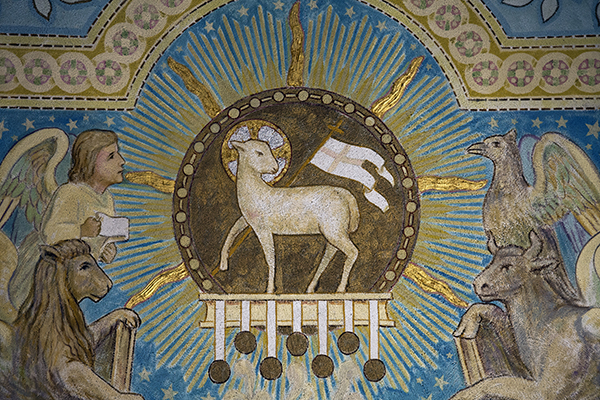January 20, 2008
John 1: 29 – 34
The scriptures use images to try to tell us who God is and who Jesus is. In today’s Gospel we receive a very important image. When John the Baptist sees Jesus coming towards him he says, “Behold the Lamb of God.” Now what does this image mean? Why does John call Jesus a lamb? It seems like such a soft symbol. Is John saying Jesus is cute and cuddly? Not at all. Anyone at the time of Jesus would know immediately the significance of a lamb. Lambs were associated with sacrifice. In the temple of Jerusalem lambs were killed to atone for the sins of Israel. So when John calls Jesus a lamb, he is pointing to Jesus’ sacrifice on the cross. A sacrifice which we believe atones for our sins and reconciles us to God. But what makes Jesus’ sacrifice effective is not that it is bloody but that it is motivated by love. And so calling Jesus a lamb is pointing to Jesus’ sacrificial love by which we are saved. We are called to imitate Jesus action, to live with sacrificial love.
He was eight years old and in a hospital room anticipating a serious operation. He was afraid. He asked his doctor, “What is it like to die?” His doctor said, “You’re not going to die, don’t worry about it.” The nurses and the medical staff assured him there was nothing to worry about and that he should put his fear out of his mind. But no one would speak to him about death. So he continued to be afraid. One night a woman on the maintenance staff came in to mop the floor of his room. The boy asked her, “Are you afraid to die?” “Yes I am,” she said and she put down her mop and pulled a chair up to his bed. “I am afraid but I believe that God is with me.” She spoke to the boy as an equal not as a superior. She told him of her belief of God and the comfort that she took in the words of Jesus. The two of them spoke for some time. When she left, he was at peace because someone had hear his question and listened to his fear. Behold the Lamb of God.
You had a tough day at school and yes today you have homework. Before you get to it, you are spending some time at the computer surfing the net. You notice through the window that your mother has just pulled into the driveway and opened the trunk. The trunk is filled with groceries. Funny, but you never reflected before on how many groceries it takes to feed your family. The bags look heavy, and your mom looks tired. Exhausted would be a better word. She gets that way after running around for hours. You turn back to the computer screen, but then you stop and you make a decision. You put on your coat and go out into the driveway and help her carry the heavy bags into the kitchen. Then you say to her “I’ll put these away. I know where they go.” Behold the Lamb of God.
She was only 27 and in the last month lost both her father and her mother. Her husband and she did not know how to cope with the loss. They never faced anything like this before. She was devastated and found it difficult at times to make it through the day. Her husband for his part felt keenly inadequate. He could not figure out what to do to lift her grief. Then the evening came for them to go and see the musical Wicked. They had bought tickets months ago. Two of the leads sang a song that reminded her of her mother and she began to weep. Suddenly her husband realized what his role was—to hold her hand, to have the Kleenexes ready, and to let her know that he would still be there when the music ended and the lights came back on. Behold the Lamb of God.
Every day you and I have opportunities to act with sacrificial love, to set aside our agenda and our priorities and to reach out to someone else in generosity and compassion. Every time we take up one of those opportunities, the Lamb of God continues to walk in our midst. Christ uses our actions of sacrificial love to continue to bless and heal. When we seize the opportunities that are presented, Christ continues to save the world through us.

